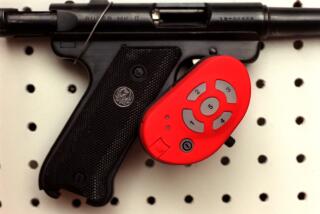The Burial of the Guns
- Share via
For two hours Saturday morning, the two hearses rolled through Inglewood, Lennox and South Los Angeles, often with police escort. One of them carried a baby blue-hued coffin. Two dozen cars trailed them.
Passersby stopped to stare, wave, pump a fist or wonder aloud who had died. Those in the motorcade used bullhorns to bellow, “Stop the violence, increase the peace.”
There was no one to bury. The procession was part of a mock funeral motorcade to mourn victims of violence -- particularly gang violence -- across a large swath of the Los Angeles basin.
In the end, the motorcade turned down a cul-de-sac and stopped at Darby Park in Inglewood. The coffin was rolled out of one hearse as attendees gathered around to watch two handguns being symbolically placed on the coffin’s pillow.
“We bury far too many people on a monthly basis as a result of homicides,” said Curtis Morris, 51, director of the Simpson Family Mortuary, which provided one of the hearses.
“We see the families bruised by the violence -- it comes right to our front door,” he said.
As the procession gathered in the morning, Delia Council looked around and expressed surprise more people weren’t participating.
“I don’t understand,” said Council, executive director of the group Inglewood’s Coalition. “We started this because the violence is almost like a way of life for these communities. And it’s going to continue until people get up and say, ‘Not on my block.’ ”
Violence across the city of Los Angeles and L.A. County is down from its heyday in the early 1990s. Citywide, there were 454 homicides through Nov. 17 compared with 456 last year, according to the Los Angeles Police Department.
Similarly, homicides countywide are on pace to match last year’s total of about 1,300, according to the Sheriff’s Department. In the early 1990s, homicides topped 2,000 a year.
Even with those statistics, organizers of Saturday’s rally say the number of homicides is intolerable.
“Right now, our communities and families are out of balance, and we need to stop being in denial of that,” said Carol Scott, who, as assistant minister of Holy Trinity Evangelical Lutheran Church in Inglewood, presided over the burial of the guns.
Nearly everyone in the procession had a story to tell of violence and how it had altered, or nearly ended, their lives. Tow truck driver Darryl White, 41, wore his uniform with “R.I.P. Big Shaun” written on the leg.
“Big Shaun” was a friend and former colleague who was shot dead outside his home last May. White said it wasn’t even a matter of being in the wrong place at the wrong time, as is so often the case.
“He wasn’t in the wrong place -- he was in front of his house,” White said. “I’m here because this is something Shaun would have done.”
As with any event about gang violence, there were people trying to explain it, or at the least understand it. Many in attendance offered their own theories: too many guns, too few activities for children, too many broken homes, too little love.
“I got out when I got a gun pulled on me on Crenshaw a few years back,” said Antwione Sims, 21, of Inglewood. “It scared the hell out of me. I closed my eyes and said, ‘God, if you’re going to take me, take me.’ ”
With a young son to take care of, Sims got out of the gang life. Today, he works at Gold’s Gym and takes classes at El Camino College.
Thaddeus Carroll, 50, had also just gotten out -- of state prison -- and said he had spent more than half of his life behind bars. He said he began running with gangs in the late 1960s.
The worst part about it, he said, is that his son is also in state prison. “Man, I’m hurting. I’ve got a son doing 28 to life because he wanted to be like me.”
More to Read
Sign up for Essential California
The most important California stories and recommendations in your inbox every morning.
You may occasionally receive promotional content from the Los Angeles Times.










